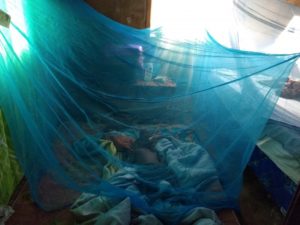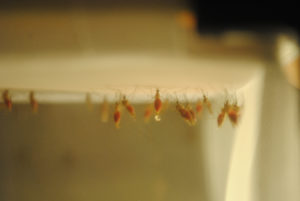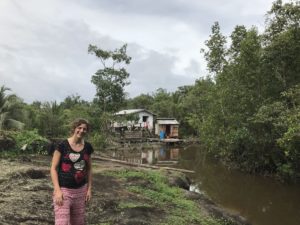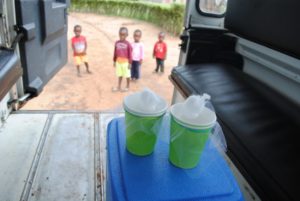The overall objective of the Huijben lab is to investigate optimal strategies for containment of antimalarial resistance in malaria parasites and insecticide resistance in disease-transmitting mosquitoes while optimizing disease control. We approach this by a combination of working with field-derived samples, empirical data derived from evolutionary experiments in the lab and, in collaboration, with mathematical modeling. Currently we work on the following research projects.
Understand the relation between insecticide resistance and malaria epidemiology.
The aim of vector control in the context of malaria is not to kill the mosquito per se, but to block or reduce disease transmission. While widespread mosquito resistance has been observed, impact on disease transmission might not be as severe as feared for the following reasons: (i) incorrect definition of ‘resistance’: survival in a 30 minutes or 24-hour bio-assay does not take increased mortality later in life into account, (ii) non-mortality effects: reduced vector competence despite survival, (iii) bednets still provide a physical barrier between host and vector, (iv) insecticide-parasite interactions that enhance (or decrease) transmission and (v) low frequency of resistance when taking all vector competent species into account. Biological data is largely lacking on much of the above. Our goal is to (i) gather biological data on the above factors using insecticide-resistant and –susceptible Aedes aegyptii in the lab and (ii) to incorporate these indirect effects into a mathematical model (in collaboration with Prof Abba Gumel from the Mathematics Department at ASU) to gain better understanding of the relation between insecticide resistance and malaria epidemiology.
not to kill the mosquito per se, but to block or reduce disease transmission. While widespread mosquito resistance has been observed, impact on disease transmission might not be as severe as feared for the following reasons: (i) incorrect definition of ‘resistance’: survival in a 30 minutes or 24-hour bio-assay does not take increased mortality later in life into account, (ii) non-mortality effects: reduced vector competence despite survival, (iii) bednets still provide a physical barrier between host and vector, (iv) insecticide-parasite interactions that enhance (or decrease) transmission and (v) low frequency of resistance when taking all vector competent species into account. Biological data is largely lacking on much of the above. Our goal is to (i) gather biological data on the above factors using insecticide-resistant and –susceptible Aedes aegyptii in the lab and (ii) to incorporate these indirect effects into a mathematical model (in collaboration with Prof Abba Gumel from the Mathematics Department at ASU) to gain better understanding of the relation between insecticide resistance and malaria epidemiology.
Determine optimal insecticide resistance management strategies
Currently insecticides are being applied as a ‘mono-treatment’, i.e. a single class of insecticide is used year after year. However, we know from mono-treatment in healthcare and agriculture that this provides the strongest selective pressure for resistance. Alternatives such as combining different insecticides (mixing), rotating insecticides in time (rotation) and space (mosaic), or leaving a proportion of the population untr eated (evolutionary refugia) have been suggested but empirical data is nearly completely lacking. We intent to address this question by (i) initiating long-term evolutionary experiments starting with susceptible lab strains of Aedes aegyptii mosquitoes and (ii) perform short-term evolutionary experiments (1-2 generations) using field-collected resistant and susceptible Aedes aegyptii mosquitoes from Maricopa County, Arizona which will be combined to create mixed populations. Mosquitoes from both (i) and (ii) will be exposed to different treatment regimes and evolution of resistance will be determined using phenotypic and genetic assays. In addition, we plan to (iii) incorporate mathematical models to determine optimal treatment regimes in collaboration with Prof. Abba Gumel. These models will additionally be utilized to inform experimental design for theoretically optimal treatment regimes to test empirically for (i) and (ii).
eated (evolutionary refugia) have been suggested but empirical data is nearly completely lacking. We intent to address this question by (i) initiating long-term evolutionary experiments starting with susceptible lab strains of Aedes aegyptii mosquitoes and (ii) perform short-term evolutionary experiments (1-2 generations) using field-collected resistant and susceptible Aedes aegyptii mosquitoes from Maricopa County, Arizona which will be combined to create mixed populations. Mosquitoes from both (i) and (ii) will be exposed to different treatment regimes and evolution of resistance will be determined using phenotypic and genetic assays. In addition, we plan to (iii) incorporate mathematical models to determine optimal treatment regimes in collaboration with Prof. Abba Gumel. These models will additionally be utilized to inform experimental design for theoretically optimal treatment regimes to test empirically for (i) and (ii).
Determine optimal antimalarial resistance management strategies
Drug resistance is a major problem for malaria control and elimination. We are now down to our last first-line treatment to which resistance is already emerging in Southeast Asia. Antimalarial r esistance management is now more pressing than ever, but we lack empirical evidence on how to best do this. Similar to the above project, we aim to optimize antimalarial resistance management strategies with a combination of long-term and short-term evolutionary experiments on Plasmodium falciparum parasites cultured in vitro in the lab as well as using a mathematical approach. Moreover, we are currently in the process of developing an insectary that will allow us to study the evolution of resistant malaria parasites within the mosquito vector.
esistance management is now more pressing than ever, but we lack empirical evidence on how to best do this. Similar to the above project, we aim to optimize antimalarial resistance management strategies with a combination of long-term and short-term evolutionary experiments on Plasmodium falciparum parasites cultured in vitro in the lab as well as using a mathematical approach. Moreover, we are currently in the process of developing an insectary that will allow us to study the evolution of resistant malaria parasites within the mosquito vector.
Understand insecticide resistance patterns in the field
Insecticide resistance are rather heterogeneous in the field, why do we see such diversity in resistance patterns? What are the factors that determine the level of resistance observed in the field? How does the level of susceptibility as measured by standard bioassays translate to intervention efficacy? At our field sites in Mozambique and Guyana we collect mosquitoes from various areas, do a wide range of insecticide susceptibility assays and molecular analysis for resistance markers with the aim to understand the evolution of insecticide resistance in an intervention setting better.
